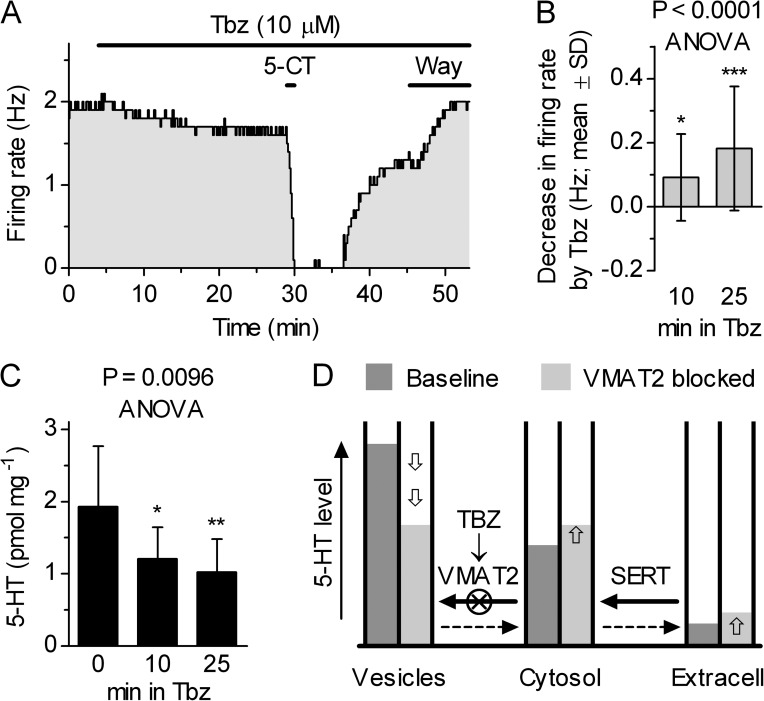Figure 5.
Effects of VMAT2 inhibitor Tbz in raphe slices. (A) Time course of a representative experiment in phenylephrine-supplemented ACSF, showing the decrease in firing rate produced by 10 µM Tbz. The neuron was confirmed serotonergic, as its firing was abolished in response to bath perfusion of the 5-HT1A receptor agonist 5-CT (10 nM). The application of 50 nM Way-100635 (Way) restored the firing rate to the level preceding Tbz, indicating that the effect of Tbz was mediated by 5-HT1A autoreceptors. (B) Histogram summarizing the effect of 10 µM Tbz on firing in phenylephrine-supplemented ACSF. Firing rates recorded at 9–10 and 22–25 min of the Tbz application were compared with the firing rate recorded during the last 5 min in control. Repeated measures one-way ANOVA revealed a significant decrease in the firing rate by Tbz (n = 19; P < 0.0001; normal distribution; P = 0.23, 0.08, and 0.09; D’Agostino and Pearson omnibus test). After 10 min of Tbz application, the firing rate was decreased by 0.092 ± 0.136 Hz (mean ± SD; *, P < 0.05; Dunnett’s post-hoc test vs. the baseline), whereas at 25 min, the firing rate was decreased by 0.182 ± 0.194 Hz (mean ± SD; ***, P < 0.001; Dunnett’s post-hoc test vs. the baseline). (C) Histogram summarizing the effect of 10 µM Tbz on 5-HT content (pmol mg−1 wet tissue) in raphe slices. Columns represent average values for nine slices obtained from nine animals. Error bars denote SD. The left column represents control slices, perfused for 30 min in the experimental chamber with ACSF containing 3 µM phenylephrine at 34°C. The middle and right columns represent slices that were additionally perfused with ACSF containing 3 µM phenylephrine and 10 µM Tbz for 10 and 25 min, respectively. The groups were significantly different (P = 0.0096; two-tail one-way ANOVA; normal distribution; P = 0.05, 0.29, and 0.97; D’Agostino and Pearson omnibus test; *, P < 0.05; **, P < 0.01; Dunnett’s post-hoc test vs. control). (D) Schematic diagram illustrating the expected redistribution of 5-HT after Tbz application. Concentration gradients of 5-HT across vesicular (>104-fold; Schuldiner et al., 1995) and plasma membrane (≥103-fold; Adams and DeFelice, 2002) are generated and maintained by VMAT2 and SERT, respectively. Block of VMAT by Tbz slowly dissipates the 5-HT gradient across the vesicular membrane, resulting in a decrease in vesicular 5-HT concentration and an increase in cytosolic 5-HT concentration, which in turn leads to an increase in [5-HT]o via reequilibration of plasma membrane 5-HT gradient. Dashed arrows indicate flux of 5-HT down the gradient and open arrows indicate direction of changes in 5-HT concentration within each compartment. Degradation of excessive cytosolic 5-HT by MAOB (Km of ≈1.2 mM; Fowler and Tipton, 1982) limits the increase in 5-HT concentration, resulting only in a weak reduction in the firing rate.

